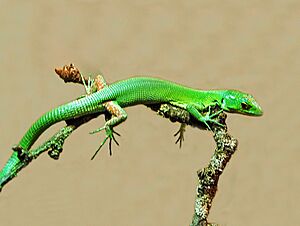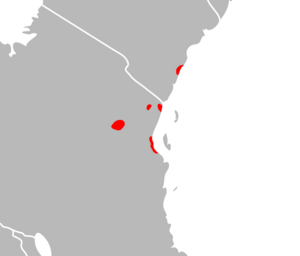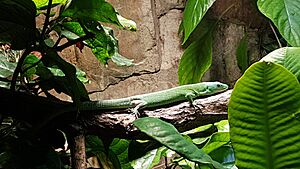Green keel-bellied lizard facts for kids
Quick facts for kids Green keel-bellied lizard |
|
|---|---|
 |
|
| Conservation status | |
| Scientific classification | |
| Genus: |
Gastropholis
|
| Species: |
prasina
|
 |
|
| The range of Gastropholis prasina on the coast of Tanzania and Kenya, shown in red | |
| Synonyms | |
|
|
The Green Keel-bellied Lizard is a cool reptile. It's a type of lizard. Scientists call it Gastropholis prasina. It belongs to the Lacertidae family, which are often called "wall lizards."
Contents
Where Does the Green Keel-bellied Lizard Live?
This lizard lives in Africa. You can find it along the coast of Kenya and Tanzania. These countries are in East Africa.
What Kind of Home Does It Like?
The Green Keel-bellied Lizard loves forests. It also lives in woodlands and thick bushes. These places are usually found near the coast. This lizard can be seen close to the ground. It also climbs high up in the trees. It uses small branches to rest on. Sometimes, it even sleeps on branches. Its long tail helps it stay balanced while sleeping.
What Does the Green Keel-bellied Lizard Look Like?
The Green Keel-bellied Lizard is a slim lizard. It has a bright green body. Its tail is very long. The tail makes up about 70% of its total body length. This long tail can even grab onto things, like a monkey's tail!
Its back scales are small and smooth. They are a beautiful emerald-green color. The scales on its belly are yellow-green. They are also keeled, which means they have a small ridge down the middle. You might see patches of turquoise near its legs. Sometimes, it has black speckled lines along its sides. Black speckles can also appear on its tail. Its tongue is bright red.
This lizard can grow up to 40 centimeters (about 16 inches) long. Most adults are between 25 and 35 centimeters (10-14 inches). Baby lizards are much smaller, around 11-12 centimeters (4-5 inches). Its fingers and toes are long and thin. Each one has a hooked claw at the end. These claws help it climb.
Green Keel-bellied Lizard Behavior and Life Cycle
This lizard is active during the day. This means it is a diurnal animal. It spends most of its time in trees. This is called being arboreal.
What Does It Eat?
The Green Keel-bellied Lizard mainly eats insects. But if it's kept in a zoo, it might eat smaller lizards too.
How Does It Reproduce?
When these lizards mate, the male bites the female's neck. Their tails also twist together. This lizard lays eggs. This means it is oviparous. In zoos, females usually lay about five eggs. They lay these eggs in the early autumn.



